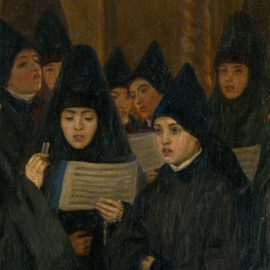

This article is an excerpt from the Shortform summary of "The Hiding Place" by Corrie ten Boom. Shortform has the world's best summaries of books you should be reading.
Like this article? Sign up for a free trial here .
What are the key events on a Corrie ten Boom timeline? How did World War 2 shape the rest of the timeline of Corrie ten Boom’s life?
This Corrie ten Boom timeline provides an overview of her life, starting with her early years in Haarlem. Read about the key events of Corrie’s life.
The Timeline of Corrie ten Boom’s Life
Starting with a happy childhood in Haarlem, Corrie ten Boom experienced many things during her life. This Corrie ten Boom timeline covers her growth, spinster years, helping Jews during the Holocaust, and her own time in a concentration camp.
Corrie ten Boom Timeline: Early Years
Cornelia “Corrie” ten Boom was born in 1892. As a child, her family held regular Bible study sessions and taught their children to live according to Christian principles. She sometimes accompanied her father on the train to business trips in Amsterdam.
When Corrie was 14, she met Karel, a classmate and close friend of her older brother Willem. She was immediately smitten with the young man, and she fantasized about a married life with him.
In January 1919, Corrie ran a test on her dabetic favorite aunt. She observed the results, praying that she was mistaken—the compound was pitch black. Tante Jans died shortly after, but her boundless energy and commitment to her work set an indelible example for Corrie.
Four months after Tante Jans’ death, Corrie, now 27, was reunited with a familiar face—Karel! Corrie and Karel began a brief courtship, during which Karel would visit the ten Boom home and take Corrie out for walks around Haarlem. Sadly, this was not to be Corrie’s fate. Willem informed Corrie that, although Karel did indeed love her, Karel’s parents wanted their daughter-in-law to have the right social pedigree and wealth.
In 1921, Corrie’s mother passed away from the effects of a cerebral hemorrhage she had suffered in 1918. Cornelia, who had not spoken coherently in years, suddenly rose to sing the hymn “Fairest Lord Jesus” at Nollie’s wedding. Mama passed away a mere four weeks later, but no one, least of all Corrie, ever forgot her moment of grace.
After these formative childhood experiences, the next phase on the Corrie ten Boom timeline is her work with the Dutch Resistance.
1940-1943: Rescuing Jews
On May 10, 1940, Nazi Germany invaded the Netherlands, making the country’s worst fears of war and occupation a reality. Although Dutch forces initially put up a stiff resistance, they were no match for the superior military might of the combined German Army and Air Force. The night of the invasion, Corrie had a terrible nightmare, one that she later came to see as a prophecy. In it, she and her family were being carried through the square on a cart, driven by four black horses. She did not know where they were being taken. This Corrie ten Boom timeline shows how her vision came true.
Corrie’s first act to rescue Jews in Haarlem was helping her neighbors, Mr. and Mrs. Weil in November 1941. In 1942, the watch shop was not yet a full-fledged safehouse but Corrie escalated her operation. The most critical challenge Corrie faced was ration cards—she needed to find a way to secure them for the Jews under her care. She did so by staging a fake robbery.
Corrie’s rescue and hiding operation was growing rapidly by spring 1943. What had started out as a small network of friends and family had expanded by this time to include 80 co-conspirators.
While the work was something Corrie felt compelled to do, it couldn’t last. In the next part of the Corrie ten Boom timeline, she and her family are arrested.
1944: Arrest, Prison, Vught, and Ravensbruck
In early 1944, one of Corrie’s operatives, a man named Jop, was captured by the Gestapo. Rolf warned Corrie that this likely signaled the beginning of the end for her rescue operation.
On the morning of February 28, 1944, Corrie was in bed, sick with the flu and flushed with fever. Suddenly, officers burst into Corrie’s room. After hours of brutality at the hands of the Gestapo, the whole ten Boom family was arrested. After being processed and registered by the Gestapo, the family was transported to the federal prison at Scheveningen.
Two weeks after her arrival at Scheveningen, Corrie was taken to the prison hospital. Two nights later, the guards called Corrie to come out of the cell. She was brought deeper and deeper into the prison, where she was finally escorted into a cell. There were no other inmates with her. She had been placed in solitary confinement.
On April 15, 1944, a month after entering solitary confinement, Corrie marked her 52nd birthday.
In late May 1944, after three months in Scheveningen, she was finally called for her hearing. She feared what would happen to her as the guards escorted her to the infamous interrogation huts.
One day early in the summer of 1944, Corrie was abruptly ordered by the guards at Scheveningen to pack out and form a line with the other women to evacuate the prison immediately. At last, Corrie saw where she and the other women were being taken: the Vught concentration camp for political prisoners.
In July, Corrie was assigned to a slave labor unit in the Philips factory at the camp, assembling parts for radios for German fighter planes.
In September, one thousand women, including Corrie and Betsie, were ordered to gather their personal effects. The train began its long journey out of Vught. No one on board knew exactly where they were headed, but they knew what direction they were traveling—east, out of Holland and towards Germany. As she disembarked, Corrie knew immediately where they had arrived: Ravensbruck, the notorious women’s extermination camp.
The arrivals from Vught were moved into permanent barracks in October 1944. The ten Boom sisters—now, Prisoner 66729 and Prisoner 66730—took up residence in Barracks 28.
In December 1944, mere days after Betsie’s death, Corrie was ordered to stand to the side during roll call and report to the administration barracks. When she arrived, the clerk stamped her papers, which bore the words “CERTIFICATE OF DISCHARGE.” She was first required to go to a hospital where she was given little care. Finally, at the end of December, the doctors cleared Corrie for release.
Certainly the most challenging part of her life, this phase of Corrie ten Boom timeline set her up to come back to Haarlem and keep her focus on her faith.
1945-1983: Freedom and Renewed Purpose
On New Years Day 1945, was placed on a train bound for Berlin. Only years later did Corrie learn that her release had been the result of a clerical error—the rest of the women at the hospital in Ravensbruck were murdered in the gas chambers a mere week after Corrie left the camp.
The train only took her as far as the Dutch border town of Groningen. After a ten-day sojourn in the Groningen hospital, Corrie made it onto a food truck headed to Willem’s town of Hilversum. After two weeks in Hilversum, Corrie bade farewell to Willem and began the journey home to the Beje.
She began preaching in the streets of Haarlem in early spring 1945, while the city was still under occupation. After one of her preaching sessions, a wealthy woman offered her house as the place for Corrie’s home for concentration camp survivors. Almost immediately after the liberation of Holland in May 1945, the first wave of what would become hundreds of people scarred by the war began making their way to Corrie’s recovery house.
The timeline of Corrie ten Boom’s life culminates in her focus on the work most important to her: religious duty and spreading the word of God. She was compelled by Christian duty to take the message to all corners of the world. And for the next four decades until her death in 1983, this is precisely what she did.

———End of Preview———
Like what you just read? Read the rest of the world's best summary of Corrie ten Boom's "The Hiding Place" at Shortform .
Here's what you'll find in our full The Hiding Place summary :
- Why devout Christian Corrie ten Boom decided to stand up to the Nazi occupation
- How ten Boom and the Jewish neighbors she was hiding were caught
- How ten Boom survived the concentration camp and left with even stronger faith






